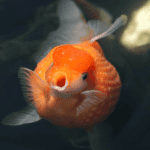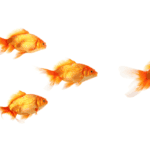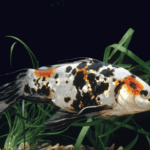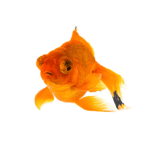Oranda Goldfish, a variety of fancy goldfish, are among the most popular types of goldfish in the world. Originating from selective breeding, their exact history is a mystery, but it’s known that they are one of the older varieties developed by Asian breeders. Descending from wild carp, specifically the Prussian carp, Orandas have captured the hearts of breeders and collectors alike, with their unique appearance and fascinating characteristics.
These goldfish are recognized by their distinct headgrowth, or “wen,” which presents as a fleshy cap on their forehead. The red-cap oranda is a notable example, boasting a silverish body with a prominent red headgrowth. Sizes of this particular species can reach eight to nine inches in length when fully grown, with the tail fin often making up around two-thirds of their overall length.
Oranda Goldfish are coldwater fish, preferring water temperatures between 65 and 72 degrees Fahrenheit. The ideal water pH ranges from 6.0 to 8.0, with a water hardness of 5 to 19 dGH. These charming fish can be found in a variety of colors and patterns, including the highly sought-after calico version, known as Azuma Nishiki.
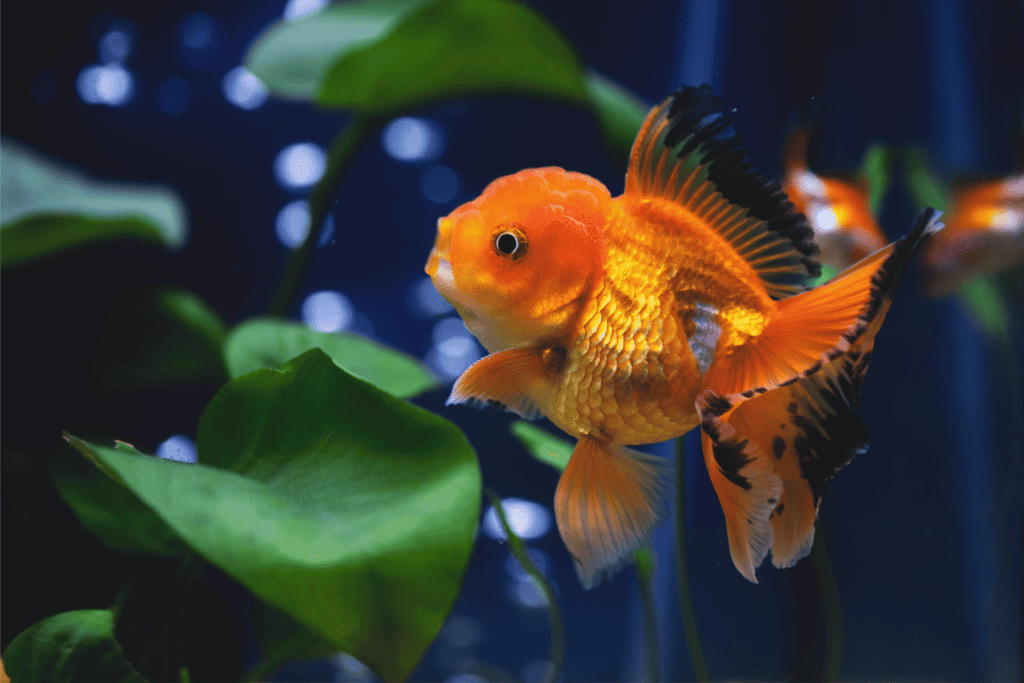
Oranda Goldfish Origins
Oranda Goldfish, one of the fancy goldfish varieties, have an interesting and debated origin story. They are believed to have roots in both China and Japan, with their closest ancestor being the Prussian carp (Carassius gibelio). The Prussian carp, originating in Central Asia, was domesticated in China over a thousand years ago.
Early records of the Oranda Goldfish can be traced back to the 15th century, making them one of the many fancy goldfish species created in East Asia. Chinese breeders have played an essential role in introducing new variations, such as the telescope-eyed oranda – a cross between the telescope eye and oranda goldfish.
The name “Oranda” is derived from the Chinese term meaning “flower of the water,” which refers to their flowing fins and unique head growth. Their large, round scales can be either matte or metallic, and they are best known for their fan-shaped tail fin and symmetrical appearance.
Today, Oranda Goldfish are a popular choice for aquariums and ponds worldwide. Their distinct appearance, with the crown-like head growth and vibrant colors, adds beauty and grace to any aquatic environment. With proper care and attention, these stunning fish can thrive and bring joy to their caretakers for years to come.
Physical Characteristics
Color Varieties
Oranda goldfish come in a variety of colors, including:
- Red
- Red and white
- Blue
- Chocolate
- Calico
- Black
- Red and black
- Silver
- Yellow
These distinct color patterns give them a unique and attractive appearance, making them popular among goldfish enthusiasts.
Size
Oranda goldfish can grow quite large in comparison to other goldfish breeds. They can reach a size of up to 12 inches (30 cm) in length when provided with adequate space and proper care. The size of an Oranda goldfish will be affected by factors such as genetics, diet, and living conditions. It is essential to provide a spacious tank or pond to accommodate their growth and ensure their well-being.
Unique Features
The most distinguishing feature of an Oranda goldfish is the prominent bubble-like “hood” on their head, also known as “wen” or “crown.” The hood can be a prominent growth on the top of the head (cranial region) or may encase the entire face except for the mouth. This hood gives the Oranda goldfish a unique and eye-catching look, contributing to their popularity in the goldfish hobby.
Orandas are also known for their peaceful temperament, making them a great choice for a community tank or pond as they get along well with other peaceful fish species. Their life expectancy can range from 8 to 15 years, with some even reaching 20 years of age when given proper care and an adequate living environment.
Habitat Requirements
Oranda Goldfish are a popular type of fancy goldfish, selectively bred, and not found in the wild. They are primarily kept as pets in indoor aquariums and can also be well-suited to pond systems. In this section, we will discuss the habitat requirements for Oranda Goldfish, including tank size and water parameters.
Tank Size
It is essential to provide the Oranda Goldfish with a spacious and comfortable living environment. A general recommendation is to have a tank with a minimum size of 20 gallons for a single fish. However, as Oranda Goldfish can grow quite large (up to 12 inches in outdoor ponds), it is better to opt for a larger tank when possible. For each additional goldfish, you should add a minimum of 10 gallons of tank capacity.
Water Parameters
Maintaining appropriate water parameters is crucial to the health and well-being of your Oranda Goldfish. Below is a summary of the ideal water parameters for these fish:
- Temperature: 65 to 72 degrees Fahrenheit
- pH Levels: 6.0 to 8.0 (neutral)
- Water Hardness: 4 to 20 dGH
It is essential to regularly monitor the water parameters, as goldfish are sensitive to changes in their environment. Utilizing a powerful external filter system is advisable since Orandas produce a lot of waste. Make sure to routinely check and maintain the filtration system for optimal water quality.
Remember to avoid exaggerations and false claims while providing accurate and helpful information to ensure the readers have a successful and enjoyable fishkeeping experience with their Oranda Goldfish.
Diet and Nutrition
Oranda goldfish are omnivores, which means they will eat a variety of food items. Their diet should consist of high-quality flakes, pellets, and frozen foods. It is essential to provide a balanced diet that meets their nutritional requirements.
However, fancy goldfish, including Oranda, can be prone to gastric problems if fed exclusively on dried food. This can lead to constipation, bloat, and swim bladder issues. To prevent these problems, it is recommended to include the following in their diet:
- Live or frozen food, such as brine shrimp, daphnia, and bloodworms, which can aid digestion and provide essential nutrients.
- Vegetables like lettuce, spinach, and peas, which provide fiber and variety in their diet. Make sure to blanch the vegetables before feeding.
Remember not to overfeed your Oranda goldfish, as this can cause health issues. Feed them small amounts at least two to three times a day, making sure they consume it all in about two minutes.
When choosing food for your Oranda goldfish, consider the following points:
- Look for high-quality goldfish food from reputable brands.
- Choose a mix of flakes, pellets, and frozen or live food to provide a balanced diet.
- Consider the size of your fish when selecting food, as smaller fish may have difficulty consuming larger pellets.
Proper nutrition is key to keeping your Oranda goldfish healthy and happy. By providing a balanced, varied diet, you can ensure your fish thrive in their environment.
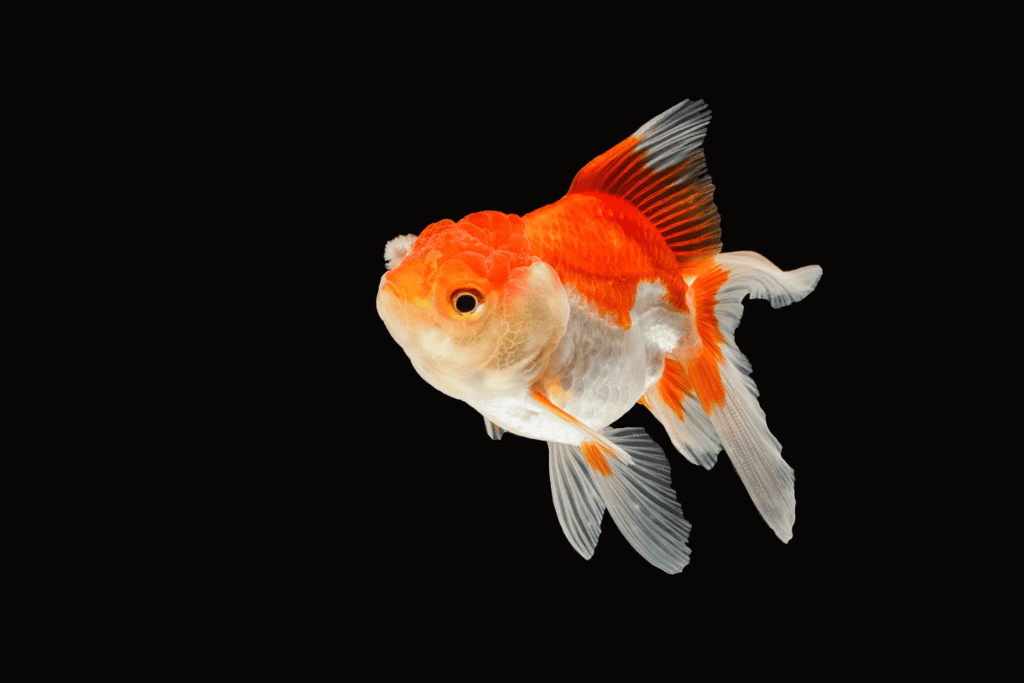
Behavior and Compatibility
Oranda Goldfish are known for their peaceful and passive demeanor. They are considered weak swimmers due to their egg-like shape and fin distribution, and are often seen swimming slowly around the tank or floating casually without a care in the world[^4^].
When it comes to compatibility, Oranda Goldfish thrive when kept with other fish of their species or those with similar characteristics. They are gregarious creatures and will do well on their own or in small schools[^3^]. Cold-water fish with a similar temperament, size, and care requirements make ideal tank mates for Orandas[^1^].
Some compatible tank mates include:
- Ryukin Goldfish: They share similar care requirements and dietary needs with Orandas[^1^].
- Cherry Barbs: These small, red barbs are considered friendly towards other fish and can be kept with goldfish without compatibility issues[^2^].
It is essential to observe the behavior of the Oranda Goldfish and its potential tank mates when introducing new fish into the aquarium. A healthy Oranda should be active, alert, and responsive to its surroundings[^1^].
Remember to ensure that the aquarium water is maintained at optimal conditions, with a temperature of around 72 degrees Fahrenheit for Cherry Barbs to thrive[^2^].
Health and Common Diseases
Oranda Goldfish are generally hardy fish, but they can be susceptible to a variety of diseases if kept in suboptimal conditions. Maintaining a clean, stable environment and providing proper nutrition can greatly reduce the risk of illness. Here are some common diseases that can affect Oranda Goldfish:
Ich (White Spot Disease)
Ich, or Ichthyophthirius multifiliis, is a common parasitic disease in goldfish. It appears as tiny white dots on the fish’s body and fins. Infected fish may also show signs of lethargy, loss of appetite, and rapid respiratory rates. To treat Ich, increase the water temperature to 86°F (30°C) for a few days, and consider using a parasite treatment available at most pet stores.
Swim Bladder Disease
Swim Bladder Disease can affect a goldfish’s buoyancy, causing it to float at the surface or have difficulty swimming. Feeding high-quality sinking pellets and maintaining pristine water quality can help prevent this disorder. If pellets float, try pre-soaking them and gently squeezing them before feeding them to the fish.
Flukes
Mongenean trematodes or “Flukes” are another common parasitic infection in goldfish. Symptoms include excessive slime production, listlessness, and reddened fins. Flukes can be treated with a variety of anti-parasitic medications or salt baths.
Costia
Ichthyobodo, also known as Costia, is a protozoan parasite that can result in severe infections. Costia-infested fish may display grayish-white patches on their skin, rapid breathing, and lethargy. Treatment options include salt baths or medication specifically designed for protozoan infections.
Anchor Worms and Fish Lice
Goldfish can also suffer from external parasites like Learnea spp. (Anchor worms) and Argulus spp. (Fish lice). These parasites can cause irritation, inflammation, and ulcers on the fish’s skin. Treatment options include manual removal of visible parasites and medication to target specific parasites.
Preventing diseases in Oranda Goldfish is best achieved through proper care and maintenance. Keep a strict quarantine protocol for new fish and follow best practices for maintaining a healthy aquatic environment to avoid many common diseases from affecting your goldfish.
Breeding Oranda Goldfish
Breeding Oranda goldfish can provide an exciting and fulfilling experience for fish enthusiasts. However, it’s essential to ensure the best possible outcome by considering several key factors.
First, make sure that your breeding pair is healthy and mature. Oranda fancy goldfish typically reach sexual maturity at around 2-3 years of age. Prepare the tank for breeding by gradually raising the water temperature to about 74°F (23°C), which encourages spawning behavior. Add live plants or spawning mops to the tank, providing a place for the female Oranda to deposit her eggs and the male to fertilize them.
Below are essential tank specifications for breeding Oranda Goldfish:
- Tank size: Minimum 20 gallons
- Temperature: Consistent between 20-22 degrees Celsius (68-71F)
- Water hardness: Between 6 and 18 DH
- pH levels: Between 5 and 8
Once the breeding pair is selected and the tank environment prepared, it’s essential to pay attention to their diet. Feed them with high-quality, protein-rich food to ensure they have the energy for breeding.
When mating begins, the male Oranda will chase the female and nudge her sides, stimulating her to release eggs. After the eggs are released and fertilized, it’s crucial to separate the adult fish from the eggs to prevent them from being eaten. It takes about 3-7 days for the eggs to hatch, depending on the water temperature.
Newly hatched Oranda fry are fragile, so it’s crucial to provide them with the proper care and nutrition:
- Keep them in a separate tank or breeding net for protection
- Maintain a stable water temperature between 68-71°F (20-22°C)
- Feed them with high-quality, easily digestible fry food, such as brine shrimp, daphnia, or crushed flake food
In summary, to breed Oranda Goldfish successfully, focus on selecting a healthy, mature pair, preparing the ideal tank environment, and providing proper nutrition and care for both adults and fry.
Tips for Oranda Goldfish Care
Oranda Goldfish are beautiful and hardy fish, but they require specific conditions to thrive. In this section, we will discuss the key elements of keeping Oranda Goldfish healthy and happy.
Water Parameters
Maintain the water temperature between 65-72 degrees Fahrenheit. Orandas prefer slightly warmer water compared to other goldfish, so aim for the upper end of the temperature range. Keep the water hardness between 4 and 20 dGH, and maintain a neutral pH level of 6.0-8.0. Monitor the water parameters regularly to ensure consistency.
Aquarium Size and Setup
Oranda Goldfish typically grow between 8 to 12 inches in length, and they have a thick-bodied appearance throughout their life. Due to this, it’s crucial to provide a spacious aquarium. A general rule of thumb is to allow at least one gallon of water per one inch of fish. However, larger aquariums are recommended for better water quality and stability.
Include decorations, hiding spots, and plants in the aquarium to create a comfortable environment for the fish. However, avoid sharp objects, as they can damage the Oranda’s delicate fins.
Filtration and Water Quality
Adequate filtration is essential to remove waste and ammonia from the water. Opt for a high-quality filter that can handle the size of your aquarium and the bioload produced by your Oranda Goldfish. Perform regular water changes, around 25-30% weekly, to maintain optimal water quality.
Diet and Feeding
Oranda Goldfish are omnivores and require a balanced diet of high-quality goldfish-specific pellets or flakes, as well as occasional treats like live and frozen foods such as daphnia and brine shrimp. Feed your Oranda two to three small meals per day, and make sure not to overfeed, as it can lead to poor water quality and digestive issues.
Tank Mates
Oranda Goldfish are social fish and do well with other goldfish varieties. However, avoid housing them with aggressive or fast-swimming fish that may out-compete them for food or bully them. Suitable tank mates include other fancy goldfish, such as Ryukin or Telescope goldfish.

